
The Jupiter trojans, commonly called trojan asteroids or simply trojans, are a large group of asteroids that share the planet Jupiter's orbit around the Sun. Relative to Jupiter, each trojan librates around one of Jupiter's stable Lagrange points: either L4, existing 60° ahead of the planet in its orbit, or L5, 60° behind. Jupiter trojans are distributed in two elongated, curved regions around these Lagrangian points with an average semi-major axis of about 5.2 AU.

A natural satellite is, in the most common usage, an astronomical body that orbits a planet, dwarf planet, or small Solar System body. Natural satellites are colloquially referred to as moons, a derivation from the Moon of Earth.

A minor-planet moon is an astronomical object that orbits a minor planet as its natural satellite. As of January 2022, there are 457 minor planets known or suspected to have moons. Discoveries of minor-planet moons are important because the determination of their orbits provides estimates on the mass and density of the primary, allowing insights into their physical properties that are generally not otherwise accessible.

The Lick Observatory is an astronomical observatory owned and operated by the University of California. It is on the summit of Mount Hamilton, in the Diablo Range just east of San Jose, California, United States. The observatory is managed by the University of California Observatories, with headquarters on the University of California, Santa Cruz campus, where its scientific staff moved in the mid-1960s. It is named after James Lick.
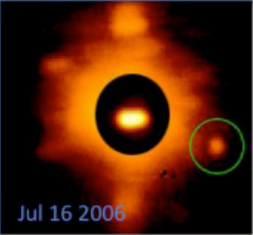
624 Hektor is the largest Jupiter trojan and the namesake of the Hektor family, with a highly elongated shape equivalent in volume to a sphere of approximately 225 to 250 kilometers diameter. It was discovered on 10 February 1907, by astronomer August Kopff at Heidelberg Observatory in southwest Germany, and named after the Trojan prince Hector, from Greek mythology. It has one small 12-kilometer sized satellite, Skamandrios, discovered in 2006.

The Discovery Program is a series of Solar System exploration missions funded by the U.S. National Aeronautics and Space Administration (NASA) through its Planetary Missions Program Office. The cost of each mission is capped at a lower level than missions from NASA's New Frontiers or Flagship Programs. As a result, Discovery missions tend to be more focused on a specific scientific goal rather than serving a general purpose.

There are 95 moons of Jupiter with confirmed orbits as of 23 March 2023. This number does not include a number of meter-sized moonlets thought to be shed from the inner moons, nor hundreds of possible kilometer-sized outer irregular moons that were only briefly captured by telescopes. All together, Jupiter's moons form a satellite system called the Jovian system. The most massive of the moons are the four Galilean moons: Io, Europa, Ganymede, and Callisto, which were independently discovered in 1610 by Galileo Galilei and Simon Marius and were the first objects found to orbit a body that was neither Earth nor the Sun. Much more recently, beginning in 1892, dozens of far smaller Jovian moons have been detected and have received the names of lovers or daughters of the Roman god Jupiter or his Greek equivalent Zeus. The Galilean moons are by far the largest and most massive objects to orbit Jupiter, with the remaining 91 known moons and the rings together composing just 0.003% of the total orbiting mass.

Antiope is a double asteroid in the outer asteroid belt. It was discovered on October 1, 1866, by Robert Luther. In 2000, it was found to consist of two almost-equally-sized bodies orbiting each other. At average diameters of about 88 km and 84 km, both components are among the 500 largest asteroids. Antiope is a member of the Themis family of asteroids that share similar orbital elements.
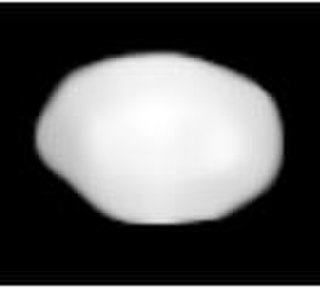
Eugenia is a large asteroid of the asteroid belt. It is famed as one of the first asteroids to be found to have a moon orbiting it. It was also the second triple asteroid to be discovered, after 87 Sylvia.

617 Patroclus is a large binary Jupiter trojan asteroid. It is a dark D-type asteroid and a slow rotator, due to the 103-hour orbital period of its two components. It is one of five Jupiter trojan asteroids targeted by the Lucy space probe, and is scheduled for a flyby in 2033.
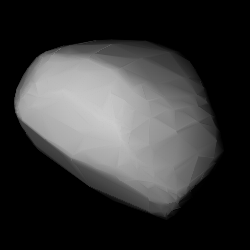
3749 Balam is a stony Flora asteroid and rare trinary system orbiting in the inner regions of asteroid belt. It also forms a secured asteroid pair with sub-kilometer sized asteroid (312497) 2009 BR60. Balam was discovered on 24 January 1982, by American astronomer Edward Bowell at Lowell's Anderson Mesa Station near Flagstaff, Arizona, and received the prov. designation 1982 BG1. It was named after Canadian astronomer David Balam. Balam measures approximately 4.1 kilometers (2.5 miles) in diameter. Its two minor-planet moons have an estimated diameter of 1.66 and 1.84 kilometers, respectively.

Remus is the inner and smaller moon of the main-belt asteroid 87 Sylvia. It follows an almost-circular and close-to-equatorial orbit around the parent asteroid. In this respect it is similar to the other Sylvian moon Romulus.

A moonlet, minor moon, minor natural satellite, or minor satellite is a particularly small natural satellite orbiting a planet, dwarf planet, or other minor planet.

Tupan Patera is an active volcano on Jupiter's moon Io. It is located on Io's anti-Jupiter hemisphere at 18.73°S 141.13°W. Tupan consists of a volcanic crater, known as a patera, 79 kilometers across and 900 meters deep. The volcano was first seen in low-resolution observations by the two Voyager spacecraft in 1979, but volcanic activity was not seen at this volcano until June 1996 during the Galileo spacecraft's first orbit. Following this first detection of near-infrared thermal emission and subsequent detections by Galileo during the next few orbits, this volcano was formally named Tupan Patera, after the thunder god of the Tupí-Guaraní indigenous peoples in Brazil, by the International Astronomical Union in 1997.

The exploration of Io, Jupiter's innermost Galilean and third-largest moon, began with its discovery in 1610 and continues today with Earth-based observations and visits by spacecraft to the Jupiter system. Italian astronomer Galileo Galilei was the first to record an observation of Io on January 8, 1610, though Simon Marius may have also observed Io at around the same time. During the 17th century, observations of Io and the other Galilean satellites helped with the measurement of longitude by map makers and surveyors, with validation of Kepler's Third Law of planetary motion, and with measurement of the speed of light. Based on ephemerides produced by astronomer Giovanni Cassini and others, Pierre-Simon Laplace created a mathematical theory to explain the resonant orbits of three of Jupiter's moons, Io, Europa, and Ganymede. This resonance was later found to have a profound effect on the geologies of these moons. Improved telescope technology in the late 19th and 20th centuries allowed astronomers to resolve large-scale surface features on Io as well as to estimate its diameter and mass.
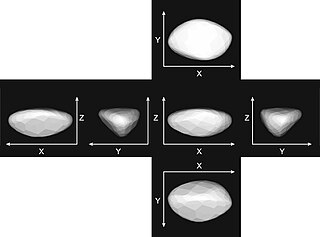
11351 Leucus is a mid-sized Jupiter trojan from the Greek camp, approximately 40 kilometers in diameter. It is a target of the Lucy mission, scheduled for a flyby in April 2028. The assumed D-type asteroid is an exceptionally slow rotator with a rotation period of 466 hours. It was discovered on 12 October 1997 by the Beijing Schmidt CCD Asteroid Program (SCAP) at Xinglong Station in the Chinese province of Hebei, and later named after the Achaean warrior Leucus from Greek mythology.
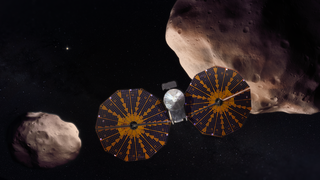
Lucy is a NASA space probe on a twelve-year journey to eight different asteroids, visiting two main belt asteroids as well as six Jupiter trojans, asteroids which share Jupiter's orbit around the Sun, orbiting either ahead of or behind the planet. All target encounters will be flyby encounters. The Lucy spacecraft is the centerpiece of a US$981 million mission.

21900 Orus is a Jupiter trojan asteroid from the Greek camp, approximately 53 kilometers in diameter, and a target of the Lucy mission to be visited in November 2028. It is among the 100 largest Jupiter trojans and has a rotation period of 13.5 hours. It was discovered on 9 November 1999, by Japanese amateur astronomer Takao Kobayashi at his private Ōizumi Observatory in Gunma Prefecture, Japan, and later named Orus after a slain Achaean warrior from the Iliad.
The selection process for Mission 13 and 14 of the Discovery program began in February 2014, as NASA drafted an Announcement of Opportunity (AO) for the next Discovery mission. The winning mission proposals received $450 million in funding towards mission development and construction, along with bonus funding if missions were able to incorporate certain technologies. For Discovery Mission 13 and 14, NASA received 28 proposals, 16 of which notably centered around small Solar System bodies. Lucy, a multiple-flyby mission to the Jupiter trojans, and Psyche, a mission to the metallic asteroid 16 Psyche, were announced as the winners of the competition in January 2017, with launches in October 2021 and October 2023, respectively.
The following outline is provided as an overview of and topical guide to Jupiter:

















